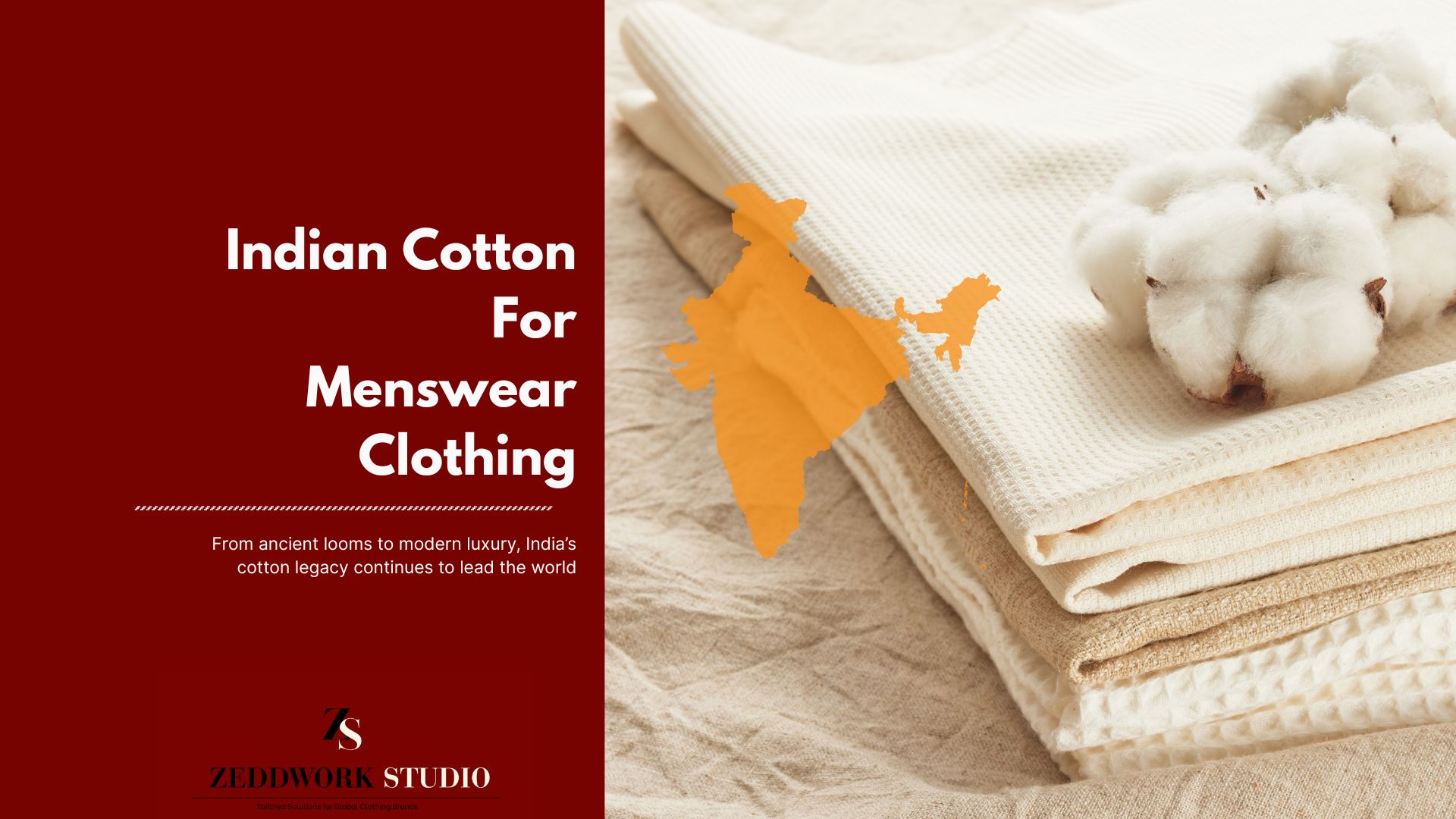There’s something unmistakable about the feel of a fine cotton shirt — soft yet crisp, structured yet breathable. It’s a quiet kind of luxury that men’s fashion has revered for centuries. But behind that understated elegance lies a remarkable story — one that begins not in Milan or Paris, but in the warm, fertile soils of India.
For global menswear brands, Indian cotton remains the gold standard — a textile that marries centuries of heritage with modern precision. From ancient looms to high-tech mills, India’s cotton continues to define how the world dresses — in comfort, confidence, and craftsmanship.
A Legacy Woven in Time
India’s relationship with cotton isn’t a trend. It’s civilization-deep.
Archaeologists have discovered woven cotton fragments from the Indus Valley Civilization (circa 2500 BCE) — some of the earliest known textiles in human history. Centuries later, these same fibres would traverse seas on trade routes connecting India to Egypt, Rome, and China.

In the 17th and 18th centuries, the fame of Indian muslins — so fine they were called “woven wind” — reshaped global commerce. The Cambridge Economic History of India describes how Indian cottons dominated European wardrobes long before industrial mills existed. Even the British Empire’s textile rise began with Indian cotton exports.
That legacy still lives in every fibre today. It’s heritage you can touch.
The Genetic Gold: Why Indian Cotton Is Different
Not all cotton is created equal. Its quality is determined primarily by staple length — the length of each fibre strand. Longer fibres yield smoother, stronger yarns that resist pilling, absorb dye better, and feel softer against the skin — qualities prized in luxury menswear.
India’s Secret Strength: Suvin and DCH-32
India is home to Suvin cotton, one of the world’s finest extra-long-staple (ELS) varieties, measuring 36–40 mm in length and with a strength of 32–36 g/tex.
By comparison:
- Egyptian Giza 45 averages 37 mm
- American Supima averages 35 mm
This puts Indian Suvin on par — and sometimes ahead — of global benchmarks. Its handfeel rivals silk; its durability surpasses most ELS cottons. No wonder international brands use it for high-end shirting, polos, and luxury suiting.
When spun into fine yarns, these fibres drape effortlessly — the reason premium Indian cotton shirts hold their shape through long workdays yet breathe in tropical climates.
The Terroir of Perfection
Like wine, cotton quality is deeply influenced by terroir — the unique combination of soil, sunlight, and rainfall.
India’s cotton grows under tropical monsoon conditions: long summers, consistent humidity, and rich black “Regur” soil across Maharashtra, Gujarat, and the Deccan Plateau. These regions retain moisture naturally and are rich in lime and iron, essential for strong, lustrous fibres.

Generations of farmers have honed techniques that balance yield with soil health — intercropping, hand-picking, and low-impact pest management. Many of these age-old practices now align with modern organic certification standards.
According to the Cotton Corporation of India, India produced approximately 6.1 million metric tonnes of cotton in 2023/24, accounting for about 24% of global output. It remains the world’s largest cotton producer — not just in quantity, but in diversity of fibre types, from short-staple everyday cottons to rare Suvin ELS grown on limited acreage in Tamil Nadu.
This unique terroir ensures that every metre of Indian cotton carries both cultural memory and climatic intelligence.
From Farm to Fashion: India’s Manufacturing Edge
India’s cotton story doesn’t end in the fields. It flows seamlessly into a vertically integrated textile ecosystem — one of the most advanced in the world.
A Vertically Integrated Powerhouse
Unlike many cotton-producing nations that rely heavily on imports for spinning or finishing, India manages almost the entire value chain domestically.
From ginning and spinning to dyeing, weaving, and garmenting, the process remains under one roof — or at least, within one country. This ensures traceability, shorter lead times, and consistent quality control.
- India’s cotton textile exports (yarn, fabrics, made-ups) reached USD 10.4 billion in 2023–24, an 8.6 % rise from the previous year (TEXPROCIL Report).
- The country supplies cotton garments to over 150 nations, with strong demand from the U.S., UK, EU, and Japan.
- Gujarat and Tamil Nadu together account for over 60 % of India’s textile exports, with hubs in Tiruppur, Surat, and Coimbatore leading innovation.
Craftsmanship Meets Technology
Indian mills combine heritage weaving with modern engineering.
They produce refined weaves like Oxford, poplin, twill, and dobby — staples of the menswear segment — and are increasingly adopting AI-driven production systems to optimize cutting, dyeing, and waste management.
For global brands seeking both artistry and efficiency, India offers scale with soul.
Sustainability: The Next Chapter in Cotton Exports
Today’s consumers don’t just buy quality — they buy values.
India’s cotton sector is at the forefront of sustainability, making it a strategic partner for eco-conscious menswear brands.
- #1 in Organic Cotton: India produces over 45 % of the world’s organic cotton, according to the Textile Exchange Organic Cotton Market Report 2024.
- Kasturi Cotton India Initiative: A government-backed program certifying traceable, high-quality Indian cotton — with QR-based transparency from farm to fabric. Know More
- Water & Energy Efficiency: Many modern mills have adopted zero-liquid-discharge systems and renewable-energy operations.

By choosing Indian cotton, brands can meet ESG targets while delivering luxury-grade products.
Why Global Menswear Brands Still Prefer Indian Cotton
Menswear demands a rare balance of structure and softness, discipline and ease. Indian cotton delivers exactly that.
1. Tailored Shirting
Long-staple cotton creates crisp yet breathable shirts ideal for businesswear and formal dressing.
2. Smart Casual & Resortwear
Cotton-linen blends and lightweight twills from India’s southern mills embody effortless elegance — ideal for European summers.
3. Streetwear & Loungewear
Heavyweight cotton fleece and French terry from Indian knit mills bring texture and durability to hoodies, sweatshirts, and joggers.
4. Artisanal Luxury
At Zeddwork Studio, we take cotton further — crafting hand-embroidered, beaded, and crocheted hoodies that merge contemporary streetwear with the artistry of Indian craftsmanship.
Each piece tells a story of tradition meeting modern design — proving that even the humblest fibre can become couture when handled with care.
| Metric | Figure | Source |
|---|---|---|
| Global Share of Cotton Production | ~24 % | USDA 2024 |
| Annual Cotton Exports (Value) | USD 10.4 B | TEXPROCIL 2024 |
| Organic Cotton Output (Share) | 45 % of global | Textile Exchange 2024 |
| Leading Export Hubs | Gujarat (35 %), Tamil Nadu (25 %) | Cotton Corp. of India |
| Menswear Cotton Fabric Exports Growth | +8.6 % YoY | TEXPROCIL 2024 |
Challenges and Opportunities
Every legacy faces evolution.
Indian cotton producers are navigating climate variability, water stress, and global price competition. Yet, these challenges are spurring innovation — from regenerative agriculture and drip-irrigation adoption to blockchain-based traceability systems.
Trade agreements like the India-UK CETA are opening duty-free access to premium markets, expected to boost cotton apparel exports by USD 1.1 billion annually over the next few years (CareEdge Ratings 2025).
In short: the world still wants Indian cotton — and India is ready to deliver it, smarter and more sustainably than ever.
The Zeddwork Studio Perspective: Where Tradition Meets Technology
At Zeddwork Studio, we believe cotton isn’t just a fabric — it’s a philosophy.
We partner with global menswear labels to transform Indian cotton into garments that embody both heritage and innovation.

Our process includes:
- Design & 3D Sampling for visualizing collections before production
- Sustainable Sourcing of Indian cotton, organic blends, and eco-certified dyes
- Artisan Collaboration for embroidery, beading, and crochet embellishments
- Lean Manufacturing Systems for scalable, ethical apparel exports
From premium shirting to elevated streetwear, every piece we produce carries the quiet confidence of Indian cotton — refined, reliable, and real.
Conclusion: The Fabric That Never Fails
Indian cotton isn’t just the foundation of the textile industry — it’s the fabric that built global fashion.
Its fibres have dressed emperors and entrepreneurs, monks and models. And as the world of menswear evolves toward authenticity and responsibility, Indian cotton continues to lead — proof that true quality never goes out of style.
For menswear brands seeking a textile partner who understands both craft and commerce, the answer is simple:
Start where it all began.
Let’s Build With Intention
If you’re a menswear label, designer, or sourcing head looking for a trusted apparel manufacturer or garment exporter in India, reach out to Zeddwork Studio. Together, we’ll craft collections that honor heritage, champion sustainability, and redefine modern luxury — one thread at a time.



